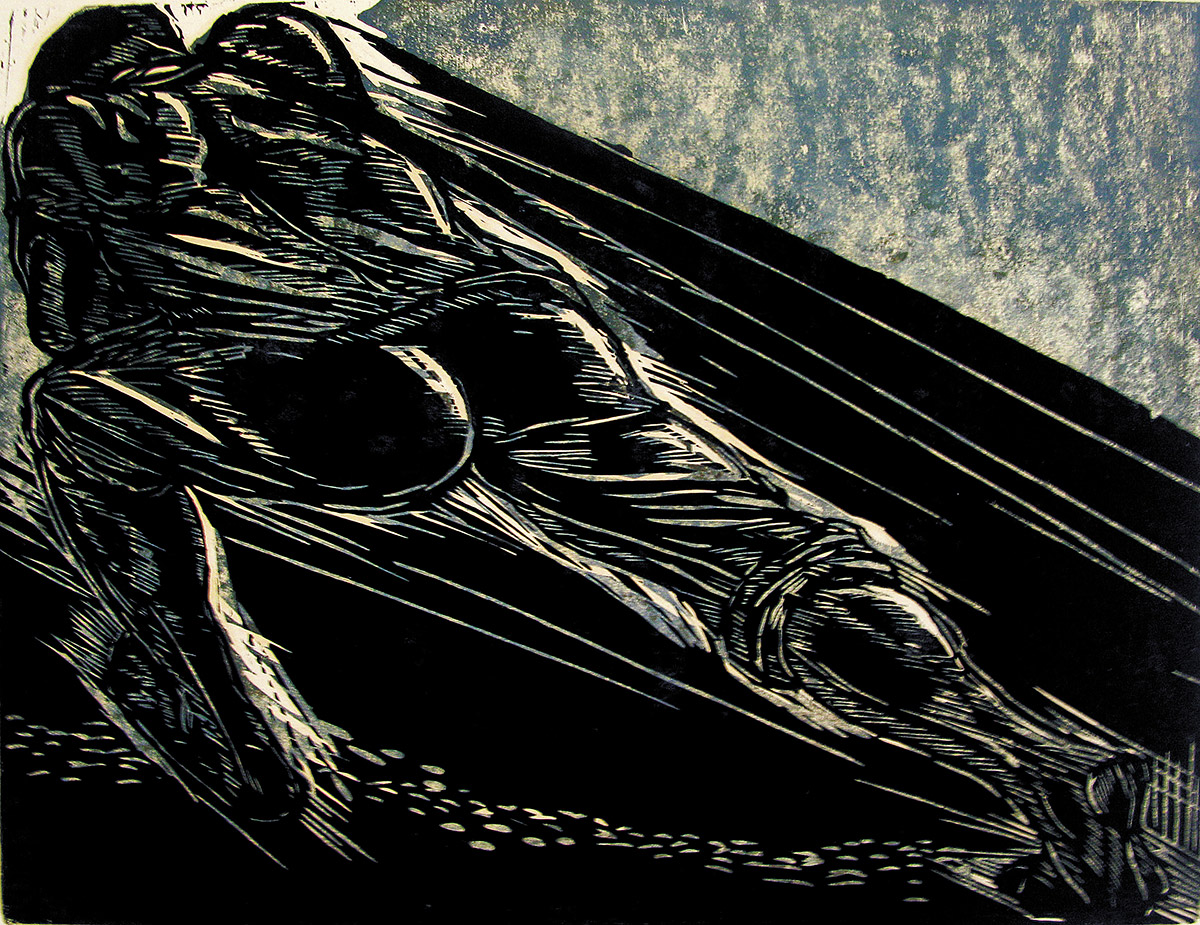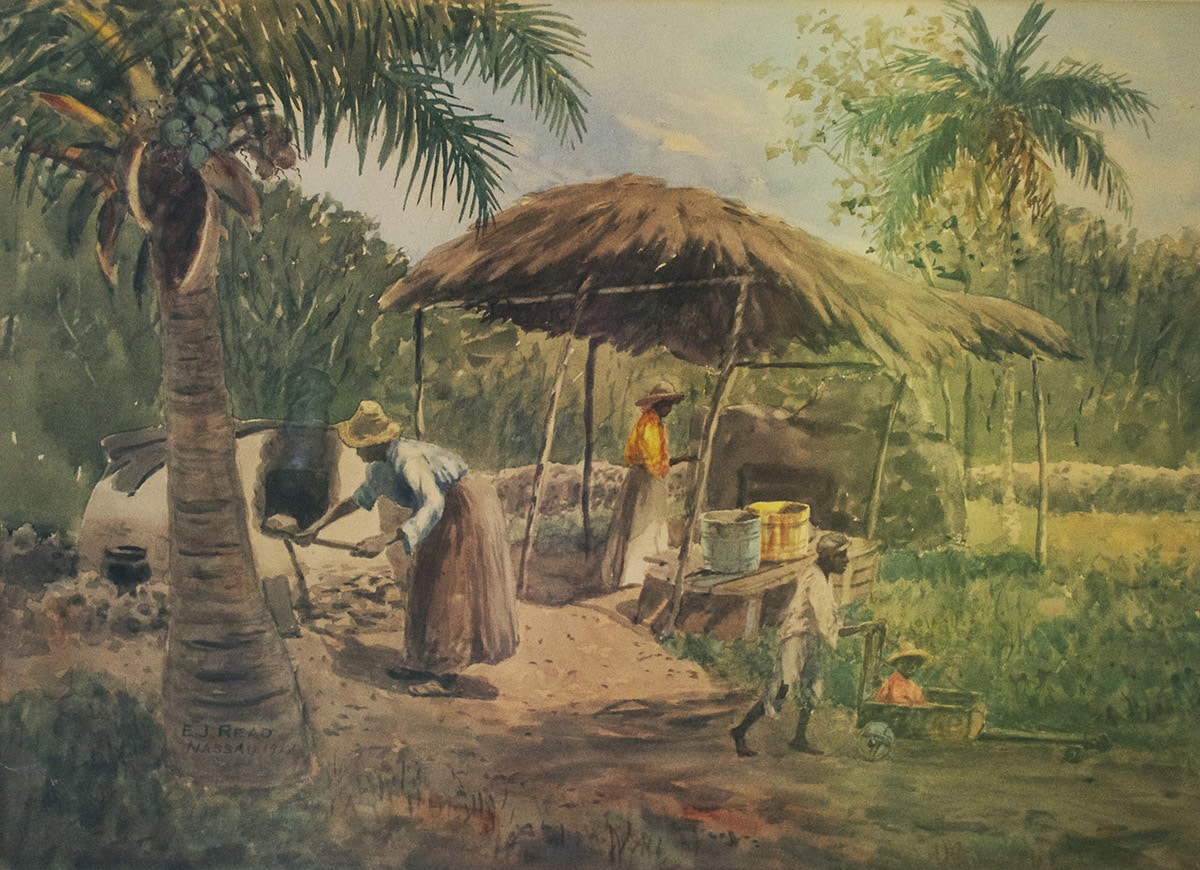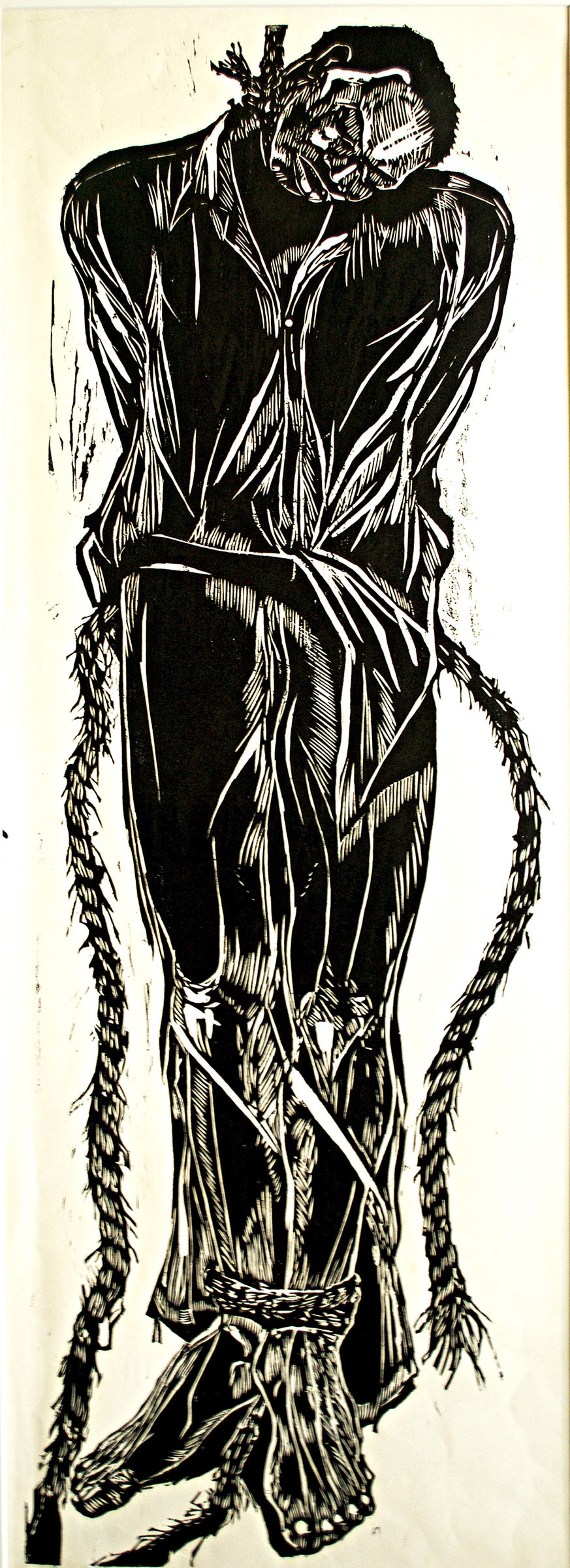
This month’s selected artwork is a woodcut print on paper entitled “Pulling Nr. 1,” (1982) by Maxwell Taylor—a painter, printmaker, sculptor, ceramicist and draughtsman. The work is currently on show alongside other Taylor drawings and prints, as well as many other artists, in the exhibition “From Columbus to Junkanoo” curated by Jodi Minnis and Averia Wright.

In 2009 The National Art Gallery of The Bahamas staged a large-scale retrospective entitled “Max Taylor: Paperwork, 1960-1992” which comprised 142 works on paper by this pioneering Bahamian artist. At that time, the NAGB invested in purchasing a suite of 95 of his works—consisting of pen and ink drawings, linocuts, woodcuts, aquatints, silkscreens, etchings, and collographs—that spanned his career, dating from as early as 1964 to 2008.
While now considered one of our leading representatives in the visual arts, Taylor struggled for many years to be accepted by his own countrymen, so it is extremely satisfying that this suite of works is now a key part of our National Collection, encompassing the arc of his practise throughout the years. “Pulling Nr, 1” exemplifies much of his printed oeuvre, the image is that of a man, seen from the back. He is gripping a rope with a huge stride—his left leg lunged forward, his right leg left stretched backward and pushing—he surges ahead, tugging on what is clearly an extreme weight. The calves of his legs are bulging with the effort, the muscles in his back are visible through his shirt, and his entire body heaves and is pitched forward in an extreme diagonal that starts with his bare foot ending at the upper left at his head, dipped with the strain of intense effort. This strong diagonal repeats itself in the scored lines that highlight his labour, while the agitated white lines and cross-hatching, which create the shading of his musculature and clothing, emphasize the tension in the image.
The figure is monumental, filling up the picture plane almost entirely, and the artist has chosen to imbue the negative space beyond his shoulder with a light mottled grey, a choice that encourages the eye to focus on the figure in the forefront, as opposed to leaving the bright paper visible, which might otherwise distract.
Like several master artists of his generation, Taylor received early art training at the famed Chelsea Pottery in the late 50s and early 60s and is both an accomplished ceramicist and painter. In those mediums, he is a vibrant colourist. In his woodcuts, however, he tends to a much starker palette, often limiting himself to the power of black and white alone, playing with the strong contrasts. While the image is striking for its intensity and vigour alone, one must also consider the particular technique within the woodcuts for which Taylor became famous, as it requires his own specific mental and technical dexterity.
The first thing the viewer must pay attention to is that there is reversal; that is, if you draw a line on paper, the line of pencil or ink will generally be dark on a light surface. With a woodcut, however, the lines—which are carved into the wooden plate—will not take the ink, so they will become the lighter points in the finished image. Then once the carved plate is inked, laid face down on the paper, and printed, the final illustration will be a mirror image of what was marked into the wood.
The artist, therefore, has to think in an entirely different way, reversing the imagery from light-to-dark and right-to-left in his or her brain, to translate the idea to the visual marker that will then be the finished product. The “Artist’s Proof” indicates that this is one of the very first prints to have been made from the plate. Often the artist will test for colour and exactitude and will also keep one print for himself. Then, at the artist’s discretion, he or she can decide how many prints will be in an edition, and each one would carry a number, to designate its place in the series. Having the Artist’s Proof indicates direct authenticity and the hand of the artist, and is therefore highly prized in any collection.
The image itself is stark and far from “pretty” in any decorative sense. Taylor delved into tough subject matter that, early in his career, was unpopular to both foreign visitors and locals alike, whose ideas of “Bahamian art” were based on beautiful representations of a tranquil reality. Even images that were supposed to show “authentic life”—such as “Clay Oven,” by ex-patriot artist E. J. Read (1912), which hangs alongside Taylor’s works in the current show—still seem to look at the hard labour of subsistence living with a sort of cheesecloth soft-focus, in which the simplicity depicted is supposed to be somehow enchanting, even seductive.

Taylor, having been inspired by masters of the past such as Francisco de Goya or Honoré Daumier, rejected this idealised image of the “native” and strived to show the reality behind the picturesque sense of simplicity, if not downright poverty. For this boldness, his work was initially rejected by most Bahamians, as it accused of revealing our collective shame. Titles of other works in our collection describe the harsh reality that existed under the beautified strata of visual imagery created for a touristic audience.
Taylor shone an unflinching and glaring light by creating works such as “Untitled (Pregnant and Alone),” 1960; “Mother’s Gone” 1970; “Aint Gat Nothing’, 1970; “Woman’s Woes,” 1978; “No Work” 1988; ‘Homeless” 1990; ‘The Pain Inside” 1992. As the dates of these works reveal, this reality has continued to the present day, with the promise of Independence broken on the shards of shattered hopes. Taylor being sensitive to the global black experience also spoke to historical moments in the rising consciousness of nations coming to terms with their formerly enslaved populations.

The stark “The Tragedy of Emmett Till” (1983), depicts a tragic low point in American history from 1955 in Mississippi when 14-year-the teenager of the same name was lynched for flirting with a white woman (also visible in the current show). Works in the National Collection such as “Cry Freedom, S.A.” (1990), or “Johnny Gone, South Africa”, (1990), also speaking to global movements in civil justice and in particular, the apartheid era. While private collectors might buy works that delight or charm them, in the formation of a National Collection, an Acquisitions Committee must consider many other criteria beyond aesthetics.
For instance, what does the artwork mean in the development of language of Bahamian visual art? What is the object’s value, not monetarily but historically or as an archival document? What story does it tell about the formation of our nation? How can it become a teaching object? Taylor’s, “Pulling Nr. 1” fulfils all the obligations of an extraordinary work, around which a narrative can be constructed that tells a story not only of our history and society but how we chose to see it, record it and view it to share with future generations.
To keep up to date on the NAGB’s upcoming shows, visit its Facebook page at https://www.facebook.com/TheNAGB or our website at https://nagb.org.bs